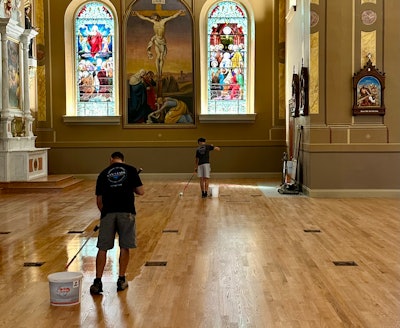

Don Jewell, Head of Technical, Loba-Wakol, LLC
When considering a water-based wood polyurethane floor finish over an oil-based polyurethane floor finish, there are several factors that make the water-based product a better choice. First, and foremost, the odor produced by oil-based poly is very strong and can linger for many weeks and take several months to fully cure. Water-based floor finishes produce very little odor, which is gone within hours and is also fully cured in no more than 7-10 days. The majority of one-component water-based finish perform at or above the level of oil-based poly. There is also the consideration of how much the oil-based poly will amber out/change color over a short period of time and will often mask the natural character of the wood flooring. In many areas, oil-based poly is still popular, but in areas where the environmental standards are higher, it is heavily restricted and rapidly losing popularity.
Water-based finish technology has drastically improved over the last 20 years and continues to do so. Oil-based poly is old technology and there is little to no investment in improving that type of finishing system. Let’s be honest, the only improvement could be to become water-based.
Equally important to note is that not all water-based finishes are created equal. Whether it is one component (1K) or the upgraded two-component (2K) products, the differences can be great. There can also be vast performance differences within each category. In general, 1K finishes will be rated for either residential or residential/light commercial and 2K finishes will be rated for medium to heavy commercial. Both classes of water-based finish should meet minimum standards for chemical resistance (typical household substances), and both should have low VOC content.
Regardless of how much you pay for a product, something sharp enough can scratch it and if you apply enough force to a small point the wood can be dented (the hardness of the wood will determine this). A dog’s nails are notorious for this. Any water-based finish for wood flooring should be able to take the indentation without cracking/crazing. So, what is often called a scratch is really an indentation where the finish is performing exactly as it should.
So why would you pay extra for the 2K finish? Well, this is where the “rubber meets the road”. It is all about the “walk-off” wear performance of a finish. In other words, how long will your finish last with normal traffic before it needs to be re-coated, or worse, re-sanded? The amount and type of traffic the floor is exposed to will affect this time greatly.
A very general guideline based on heavy residential foot traffic is:
- Standard residential performance (Loba Life or Viva) might need a re-coat in 2-5 years
- Residential/Light commercial (Loba Viva, Hybrid, or EasyFinish) might need a re-coat in 3-6 years
- Commercial (Loba Duo or Invisible Protect) might need a re-coat every 4-8 years
- Heavy Commercial (Loba Supra AT) might need a re-coat every 6-10 years.
As an example: an older couple with no pets or young children, who keep an impeccably clean house could probably apply Loba Life and never need a re-coat. By comparison, a family with two young boys and a dog, who also take proper care of their floor, would probably need to step up to EasyFinish and possibly re-coat the floor within 4-7 years. Or they could upgrade to a 2K finish like Duo or Invisible Protect and easily extend that time out to 10-15 years. Duo and Invisible Protect are suitable for high-traffic commercial spaces like museums, churches, retail, etc.
Loba also offers a “next level” product called Loba Supra AT. This is a ceramic fortified 2K finish that is recommended for applications like shopping mall corridors, restaurants, retail spaces, etc. While we state that Loba Supra AT has excellent scratch resistance, that does not mean it cannot be scratched. Remember, if something is sharp enough, it can damage any floor finish.
Proper maintenance is vital to the long-term life and performance of any floor finish regardless of the stress level that it is exposed to.
When considering if the upgrade cost is worth it for you, it is important to ask yourself
- “Am I going to properly care for my floor and finish?”
- “Is the added cost (per square foot per year) worth the extension of time between maintenance coats?”.
If the thought of recoating (i.e., moving furniture out of the space, spending time off floors, etc.) is more than you care for, or you know your floors will be “well used”, you should definitely consider upgrading your finish from a 1K to a 2K.
Regards,

Don Jewell
Head of Technical
Loba-Wakol, LLC








